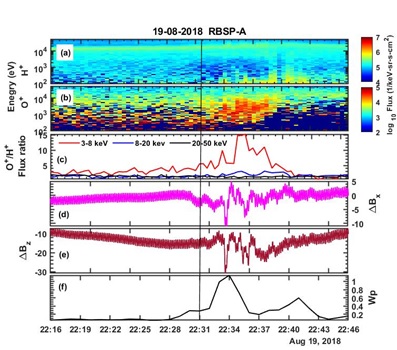
Substorm or brief disturbances in the Earth’s magnetosphere and the resultant magnetic field dipolarization (reconfiguration of the local magnetic field from stretched tail like to quasi-dipole like) increases heavy ion flux in the inner magnetosphere, providing windows for understanding the change and improving the accuracy of space weather forecasting in the future, shows a new study.
The magnetospheric substorm is a short-lived process that depends on the magnitude and direction of the Interplanetary Magnetic Field (IMF), solar wind velocity, and on the solar wind dynamic pressure. The southward direction of the IMF is a necessary prerequisite for substorm occurrence as it causes magnetic reconnection in the dayside magnetosphere. Generally, the average duration of the substorm is about 2-4 hours. During such a process, a significant amount of energy (around 1015 J) is extracted from the interaction between the solar wind and the magnetosphere. Through the course of time, this energy is ultimately deposited in the inner magnetosphere.
Using the data from the Helium, Oxygen, Proton, and Electron (HOPE) Mass Spectrometer and Electric and Magnetic Field Instrument Suite and Integrated Science (EMFISIS) instrument onboard the Radiation Belt Storm Probes (RBSP) spacecraft, scientists of Indian Institute of Geomagnetism (IIG), an autonomous institute of Department of Science and Technology conducted a statistical study of 22 substorm events for the period of 2018. They investigated the significant characteristics of magnetic field dipolarization, such as its time scale and associated enhancement in the energetic O+ and H+ ion flux.
The study published in the journal Advances in Space Research helped the scientists understand the role of plasma sheet in the transport and acceleration of ions during substorms. Such studies on the ion flux variations help in understanding the plasma in outer space relatively close to the Earth (Geospace, the area where GPS satellites and geostationary orbit satellites are flying) as it is usually composed of H+ ions. However, sometimes the proportion of O+ ions suddenly increases. The presence of these O+ ions alters the plasma dynamics of Geospace.
Such studies can help trace the cause and region of ion composition change in order to accurately understand the phenomenon and improve the accuracy of space weather forecasting in the future.
Publication link: https://doi.org/10.1016/j.asr.2023.07.011

Figure: RBSP-A data during 22:16-22:46 UT on 19 August 2018. From top to bottom displayed are (a) the energy time spectrogram for H+ ions, (b) the energy time spectrogram for O+ ions, (c) the O+/H+ flux ratio, (d) DBx, (e) DBz, and (f) the Wp index. This suggests that after the substorm onset (vertical black line), the O+ ion flux is enhanced simultaneously with the magnetic field fluctuations in panel (d) and panel (e) and also with the increase in Wp index in panel (f).
<><><><><>
SNC/PK



